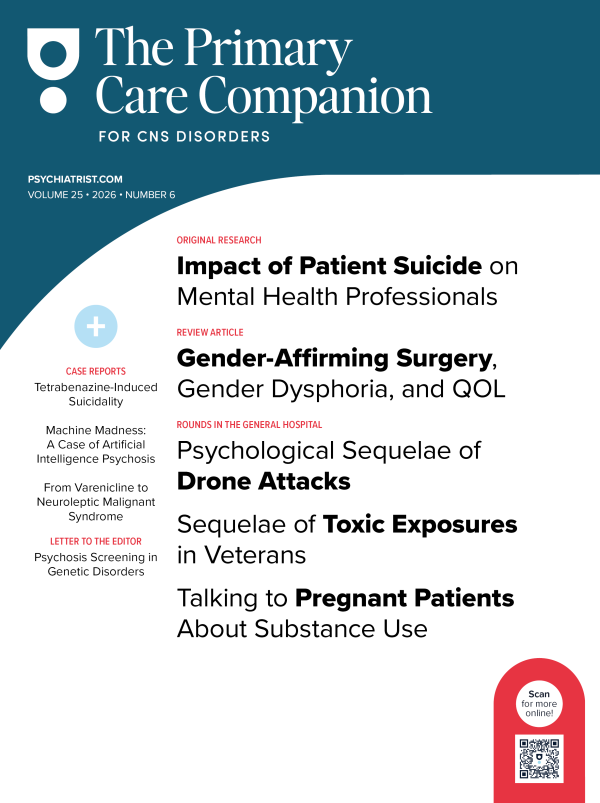Because this piece does not have an abstract, we have provided for your benefit the first 3 sentences of the full text.
To the Editor: Obsessive-compulsive disorder (OCD) can be a serious and crippling disorder. It is believed to have strong genetic components, while also being linked to childhood streptococcal infections. We report the first MEDLINE-indexed case of a patient who developed OCD after a episode of pachymeningitis.
Onset of Obsessive-Compulsive Disorder After Episode of Pachymeningitis
To the Editor: Obsessive-compulsive disorder (OCD) can be a serious and crippling disorder. It is believed to have strong genetic components, while also being linked to childhood streptococcal infections. We report the first MEDLINE-indexed case of a patient who developed OCD after a episode of pachymeningitis.
Case report. Ms A, a 52-year-old woman with a history of OCD, was being evaluated for nonepileptic seizure activity by the neurology department. Psychiatry was asked to see her for worsening anxiety related to OCD. She also had a history of pachymeningitis, which was treated in 1998. At that time, a brain biopsy was taken from her temporal lobe, and she was subsequently diagnosed with pachymeningitis. Scars were still visible on her forehead. Ms A reported that her OCD symptoms began soon after her meningitis episode. Prior to 1998, she had reported only mild depression, for which she never sought treatment.
After being previously diagnosed with OCD (DSM-IV) after the episode of pachymeningitis, she met criteria for OCD (DSM-5) on our unit. Several attempts were made to begin her on selective serotonin reuptake inhibitors, and she refused due to her exaggerated fear of side effects. She reported being focused on cleaning her home, and she often tested the air in her home for molds. Ms A also had constant worries about her health. During her hospital stay, she expressed an obsessive worry about the television in her hospital room, because the wires of the television were visible. She said that it made the entire hospital room seem messy. We started her on escitalopram 10 mg daily, which was eventually titrated to 20 mg daily. At first, Ms A was hesitant to take it because of her fears of side effects, but she eventually agreed to take the medication. With regard to her seizures, her electroencephalograph results were negative for epileptiform changes, with some changes consistent with right temporal variable firing, which neurology attributed to her brain biopsy in 1998.
Damage to specific neuroanatomical structures by various processes may be involved in the pathogenesis of at least some psychiatric disorders. Significant research has been devoted to elucidating the neural correlates of OCD.1 Reports of anxiety disorders of an obsessive-compulsive nature following various etiologies of meningitis have been reported, including streptococcus,2 toxoplasmosis,3 Japanese encephalitis,4 and immune-mediated meningitis such as through systemic lupus erythematous.5 However, this case is the first reported example of a patient who developed chronic OCD after the diagnosis of pachymeningitis. Pachymeningitis is a chronic inflammatory thickening of the meninges resulting in fibrous adhesions that can lead to variable degrees of paraparesis, paresthesia, sensory loss, and amyotrophy of the upper limb. It is associated with proliferation of immunoglobulin G4 (IgG4)-expressing plasma cells. Idiopathic hypertrophic pachymeningitis has more recently been associated with rheumatoid arthritis, whereas previously it followed syphilitic meningitis.6
It is possible that meningeal damage through various etiologies are linked as pathways for common patterns of damage to the neural structures required for resistance to psychiatric disorders such as OCD. Ongoing efforts to further correlate meningeal damage through various mechanisms with the presence of psychiatric disorders may enrich the mechanistic understanding of the neural correlates of these disorders, as well as provide a rationale for screening at-risk patients to most successfully manage the associated morbidity.
REFERENCES
1. Saxena S, Rauch SL. Functional neuroimaging and the neuroanatomy of obsessive-compulsive disorder. Psychiatr Clin North Am. 2000;23(3):563-586. PubMed doi:10.1016/S0193-953X(05)70181-7
2. Schrag A, Gilbert R, Giovannoni G, et al. Streptococcal infection, Tourette syndrome, and OCD: is there a connection? Neurology. 2009;73(16):1256-1263. PubMed doi:10.1212/WNL.0b013e3181bd10fd
3. Miman O, Mutlu EA, Ozcan O, et al. Is there any role of Toxoplasma gondii in the etiology of obsessive-compulsive disorder? Psychiatry Res. 2010;177(1-2):263-265. PubMed doi:10.1016/j.psychres.2009.12.013
4. Monnet FP. Behavioural disturbances following Japanese B encephalitis. Eur Psychiatry. 2003;18(6):269-273. PubMed doi:10.1016/j.eurpsy.2003.09.001
5. Yu C-H, Lee M-B, Tseng MM-C, et al. Obsessive-compulsive symptoms as a manifestation of neuropsychiatric systemic lupus erythematosus. J Formos Med Assoc. 2008;107(1):68-72. PubMed doi:10.1016/S0929-6646(08)60010-8
6. Ropper A, Samuels M. Disturbances of cerebrospinal fluid, including hydrocephalus, pseudotumor cerebri, and low-pressure syndromes. In: Ropper AH, Samuels MA, Klein, JP, eds. Adams & Victor’s Principles of Neurology. 10th ed. New York, NY: McGraw-Hill, 2014:617-638
Author affiliations: Department of Psychiatry, Virginia Tech Carilion School of Medicine, Roanoke.
Potential conflicts of interest: None reported.
Funding/support: None reported.
Published online: September 24, 2015.
Prim Care Companion CNS Disord 2015;17(5):doi:10.4088/PCC.15l01796
© Copyright 2015 Physicians Postgraduate Press, Inc.
Please sign in or purchase this PDF for $40.00.


